JCAEDE v2n1: Virtual Reality: Heir Apparent to CAD
Virtual Reality: Heir Apparent to CAD
Celine Pinet
Dept. of Interior Design
School of Human and Consumer Sciences
108 Tupper Hall
Ohio Uniersity
Athens, OH 45701-2979
e-mail: pinet@ostia.phy.ohiou.eduAbstract
As compared with CAD, Virtual Reality (VR) can provide a much more intuitive description of the designed space. Experts predict that, in time, Virtual Reality will become so intuitive, that it will feel like a clone of physical reality. As a result, VR will come to replace ordinary CAD. In fact, VR is already being integrated in traditional CAD software and is already starting to be used in the design profession. In light of these trends, this paper provides information about factors (e.g., real time 3D, texture mapping) important to VR world building. One of the primary challenges virtual world designers face is that of creating 3D worlds with reasonable frame update rates. Though it is presently quite challenging to design VR worlds, this powerful tool may come to affect how we teach and practice design. Designers should prepare themselves for it to become part of "real" reality.
Virtual Reality: Heir Apparent to CAD
If we were to design the perfect CAD system, what would it be like? For one thing, using it would be intuitive: The person-machine interface would work in sync with our own natural ways of processing information (Jacobson, 1994) . Just as I can move furniture around in my living room, I would be able to pick up and move a computer simulated chair with the help of a computerized data glove.
It would be easy for a designer to modify not only the design but also its structure and the interface allowing its creation (Jacobson, 1994) . The designer could pick up a computer simulated broom stick to push up various points of a computer simulated malleable ceiling (see figure 1).

Figure 1: A designer pushing up a malleable ceiling in a virtual world with a broom.
With the perfect CAD system, it would be easy for both designers and clients to readily see and understand the space being designed. Traditional sets of drawings are not easy for most clients to understand. Finally, the perfect CAD system would provide data (Jacobson, 1994) that would help viewers understand the design (e.g., information about how sunlight travels through a room).
This may all seem somewhat unrealistic. Yet the system just described, is composed of characteristics that are imbedded in the ideal of virtual reality (Jacobson, 1994) . Jaron Lanier, a leader within the virtual reality (VR) community, predicts that eventually, VR will become completely integrated with life (Porter, 1992) . In line with this, Von Schweber and Von Schweber (1995) define ideal VR as being a clone of physical reality. Interfacing with it would feel natural and intuitive.
I would go one step further by noting that VR is more than a clone of physical reality. It can also allow you to perform activities in ways that are intuitive, yet not typically possible in the real world (e.g., poking at a malleable ceiling with a broom stick). With VR, it is possible to interact with the space and to obtain information in ways not previously possible.
For example, Matsushita Corporation uses VR to help visualize air circulation in a kitchen (Du Pont, 1995) . VR provides an intuitive display of the air-flow. It helps Matsushita's employees intuitively change kitchen layouts to optimize heating and air conditioning while keeping the design appealing and the cost low.
Thus intuitive interface and information processing are already becoming part of VR simulations. Eventually, VR may well become inherent to our lives. In the mean time, Helmick (1993) warns users that VR can be overpowering. Designers and clients must be alert that their focus does not shift away from the design content to the medium itself. The focus of attention will automatically be back on the design content when VR becomes as natural to people as their immediate environment.
For the moment, VR is still primitive: A few of the VR worlds I have visited are breathtaking yet many look rather cartoonish and simplistic. The fact is that with present technology, creating good VR worlds takes a tremendous amount of time and requires expensive equipment.
Thus, it is legitimate to ask if VR will become as important for the design profession and for our society as some seem to believe. Similar skepticism would have been voiced, 100 years ago, if people would have been told about aircraft or computers. As a society, we tend to forget how often technology has been met with disbelief. T.J. Watson, who was Chair of the Board of IBM, said in 1943: "I think there is a world market for about five computers" (Peters, 1987, p. 199) . K. Olsen, who was President of DEC, said in 1977: "There is no reason for any individual to have a computer in their home" (Peters, 1987, p. 199) . Both of these predictions have obviously been proven wrong.
Until recently, virtual reality was perceived by many as an obscure scientific toy. Yet the VR market is now developing at a rapid pace (Brill, 1994; Delaney, 1996). For example, VR is becoming an important element on the world wide web. If, as designers, we do not want to be left behind, we should pay attention. VR may soon be integrated into design business practices.
According to Pate (1995) , the CAD industry is bound to be a major catalyst to the virtual reality industry. Pate predicts a need for VR world builders and states that CAD designers are well equipped to be these builders. In fact, movements in this direction are already taking place. Realizing that designers often wish to use CAD as a simulation tool, ArchiCAD recently incorporated Quick Time VR (from Apple Computer) into their basic software (Sullivan, 1996) . Similarly, Autodesk has authored a VR development tool called Cyberspace Development Kit. It allows you to navigate and interact through 3D models imported from 3D Studio and AutoCAD.
In line with this, VR applications in design are emerging in a variety of areas. White (1996) presents a kitchen he was asked to design in VRML (Virtual Reality Modeling Language) for a linoleum supplier. Trumble, Morris and Crandall (1992) write about researchers using virtual reality to help the design and evaluation of barrier-free interiors for disabled and elderly people. Mike Rosen and Associates/Building Solutions, Inc. built a Virtual Townhouse for their clients to help prospective buyers walk through the house and move furniture around months before construction (Sense8 Corporation, 1996) .
In light of these trends, designers must be prepared and prepare students for this forthcoming wave. This can be achieved by developing CAD skills and a philosophy that will be transferable to VR. The following pages introduce issues that are critical to the building of good virtual worlds.
Real Time 3D Modeling
Many are already using the term but "real time" can mean a variety of things: It primarily refers to situations where the computer images seen are entirely generated while you watch. Because real time displays involve no previous assumptions about where you look or go, it frees you to move around and interact with the scene.
This is not the case for example, if you are watching a computer simulated visit to a neighborhood and the views shown are entirely predetermined (such as in a movie). By comparison, a visit into typical computer games allows some freedom of interaction but the visit is not entirely free: There is a pre-defined set of rules. Finally, in a completely real time display, you can move freely and peek under beds or open closet doors. This is because the entire scene is constantly regenerated as as you move around.
If the scenes are rendered quickly enough as you move, you will not perceive the changes from frame to frame, and the simulated world will feel more real. The speed at which frames are updated is called the frame update rate. Anything under 10 frames per second is noticeably jerky and constantly reminds the viewer that she or he is not in a real setting.
One of the primary challenges virtual world designers face is that of creating 3D worlds with reasonable frame update rates. According to Pimentel and Teixera (1994), this constraint will not be overcome soon even though computers are getting more powerful every year.
Polygon and Vertex Counts
In any 3D computer model, the fewer polygons there are, the faster you can move around in the model. A polygon is composed of three or more lines forming a plane. The intersections of these line segments are called vertices (see figure 2).
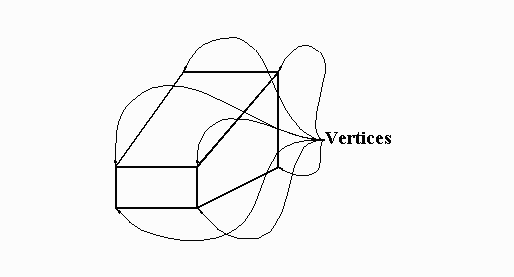
Figure 2: Three four-sided polygons with shared vertices.
Each vertex and polygon is stored in the computer. The more polygons there are, the more individual decisions the computer has to make every time the image is regenerated, the slower is the update rate. Thus it is important to reduce the number of polygons and vertices contained in a drawing.
For example, to keep polygon counts low, any polygons you cannot see should not be displayed (e.g., the faces in between two adjacent file cabinets). Polygon and vertex count can also be reduced, as explained by Blau and Yurica (1994) , by controlling the amount of detail shown at various distances. Less complex and detailed representations of an object can replace more complex ones as the viewer moves further away.
As the polygon and vertex counts are being reduced, it is important to remember that polygons and vertices should be evenly spread throughout the file. This way, no part of the world becomes much slower than others as one moves from one view point to another.
Besides polygon counts, many other factors, such as finishes, can also influence frame update rates.
Surface Finishes
In order to apply a finish, texture or color to an object, the surface must first be defined. Surfaces can be defined one by one but it will take time for the computer to process them all. It is usually much faster for the computer to process surfaces as defined by meshes (see figure 3). Meshes serve to approximate curved surfaces of solids by generating multi-edged facets (Cohn, 1993) .
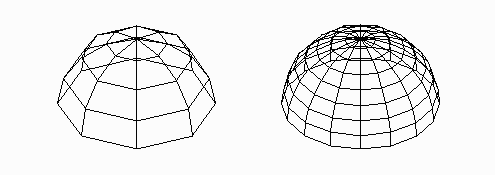
Figure 3: Two hemispheres, one with a coarse mesh, and one with a fine mesh.
A denser mesh generates a smoother, more natural looking surface but it takes longer to process. However, a coarser mesh can be made to look more natural with smoothing and Gouraud shading. For example, the right cylinder in figure 4A is made with a coarser mesh and contains half as many faces as the left one. Yet when both are smoothed and Gouraud shaded (figure 4B), the difference between them becomes hardly noticeable.
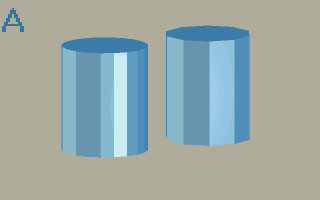
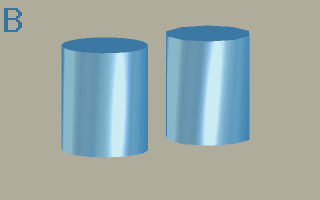
Figure 4: Gouraud shaded cylinders. In image B, the cylinders are smoothed, in A they aren't.
Texture mapping can also be used to camouflage coarse meshes or to bring realism to a surface. At Ethan Allen stores, for example, texture maps are created by scanning samples of fabrics into a computer. A swatch of fabric is "mapped" or applied onto a computer drawing of a sofa, producing an image of the sofa, with fabric on it, for the client to see.
Texture maps add realism to an object, for example, by making the sofa look as if it is upholstered. As another example, a designer would have to draw many polygons of various colors onto the floor of figure 5 in order to simulate a carpet finish. Instead, a texture map (from a scanned carpet sample) is applied to the floor providing texture while the polygon count is kept low. Experts in the field of VR state that a textured-mapped polygon is equivalent in realism to at least 10 and sometimes up to 1000 shaded polygons (Pimentel & Teixera, 1995) .
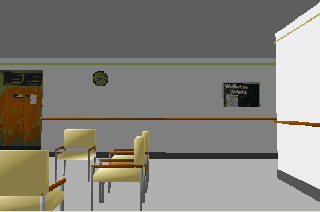
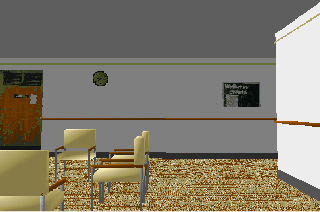
Figure 5: Two rooms, one with a carpet texture map and one without. These images are snapshots of a VR world created using VRCreator by VREAM.
However, designers should keep in mind that texture maps take long to render. If too many texture maps are used, the frame update rate will decrease substantially.
Illuminating the Space
Lighting may be more important to designers than to other virtual world builders since it is part of the design profession to be aware of its effects. There are programs, such as Lightscape, Luxicon or Radiance, that use dynamic lighting calculations to accurately portray indoor lighting. Yet those of us who have used such programs know that accurate lighting calculations takes a long time for computers to process. For the time being, most VR simulators are not powerful enough to preserve a reasonable frame update while handling accurate, but complex lighting calculations.
Fortunately, designers are trained to understand lighting. Thus they can work with the limited capabilities of VR software to create the best simulations of lighting effects possible without relying on complex computer calculations. Simple lighting models, such as distant, directional or ambient lighting, can be used to complement the simulations. These simple models do not typically slow down simulations very much (Blau & Yurica, 1994) .
Conclusion
The previous pages should have given you an idea of the current capabilities and limitations of VR. To this day, it remains quite challenging, expansive and time consuming to design virtual reality worlds. Some easy-to-use VR software are available (e.g. Virtus Walk Through Pro), but their scope is extremely confining. Head mounted displays are still primitive. Most virtual worlds look cartoonish. At the core of this discussion lies the fact that VR is still limited and that designers must be able to negotiate with these limitations.
However, I am convinced that as designers, we have an advantage when it comes to creating believable VR worlds. We are trained to know how to design visually correct spaces. We know where there should be lights and shadows, what colors are most appropriate, and what size and scales of textures are correct. Most of all, VR desperately needs world builders with good design skills (computer scientists are not trained to design pleasant spaces!). Indeed, VR opens an entirely new domain for designers to exercise their skills.
Though it is presently quite challenging to design VR worlds, this powerful tool may come to affect how we teach and practice design. It may come to expend our design potential toward new avenues. While we await for the emergence of VR from it's "oh, cool" phase, we can choose to prepare ourselves for it to become part of our reality.
References
Blau, B. & Yurica, K. (1994). Designing VR applications for the desktop. Virtual Reality World, September/October, 17-21.
Brill, L.M. (1994). Virtual reality: Designing, authoring, and toolkit cyberspace software. Virtual Reality World, 22-29.
Cohn, D. S. (1993). Complete AutoCAD. New York: Addison-Wesley Publishing Company Inc.
Delaney, B. (1996). Reflections on the appearence of VR. CyberEdge Journal, September/October, 12-13.
Du Pont, P. (1995). VR for thermal visualization: Analyzing air and temperature flow. VR world, May/June, 58-59.
Helmick, R. (1993). Virtual reality: A design simulation technique that overpowers design content . Journal of Interior Design, 19 (1), 19-24.
Jacobson, R. (1994) . Virtual worlds: A new type of design environment. Virtual Reality World, May/June, 46-52.
Pate, A. (1995). Paperback VR/CAD Worlds. VR World, March/April, 67.
Peters, T. (1987) . Thriving on chaos: Handbook for a management revolution. New York: Random House.
Pimentel , K. & Teixera, K. (1994). Virtual reality: Through the new looking glass. New York: Intel/McGrawHill.
Porter, S. (April 1992) . Interview: Jaron Lanier. Computer Graphics World, 61-70.
Sense8 Corporation (1996). Mill Valley: Sense8 Corporation.
Sullivan, A. C. (1996) . ArchiCAD Advances: Smarter drafting tools and database links strenghten Graphisoft's flagship software . Architecture, July, 131-133.
Trumble J., Morris, T. & Crandall, R. (1992). Virtual reality: Designing accessible environments. TeamRehab Report, November, 33-36.
Von Schweber, L. & Von Schweber, E. (March 14 1995). Virtual reality: Virtually here. PC Magazine, 168-170.
White, J. (1996). Designing 3D graphics: How to create real-time 3D models for games and virtual reality. New York: John Wiley and Sons, Inc.